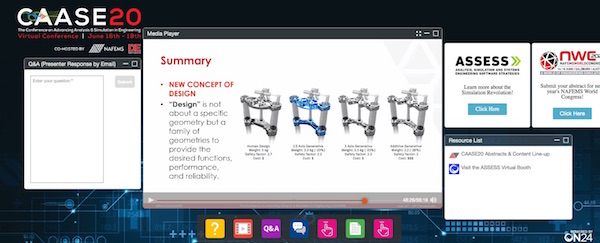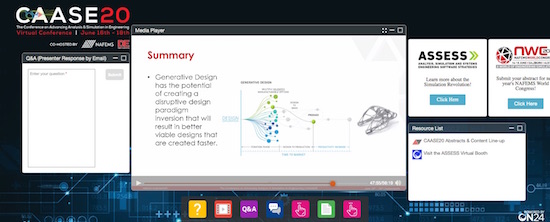Can Generative Design Spark a Design Paradigm Shift?
Generative Design’s automated processes and use of simulation early on drives designs from a performance and manufacturability perspective.

Joe Walsh of the ASSESS Initiative discussed the possibilities of generative design at CAASE20.
Latest News
June 18, 2020
There’s been lots of anticipation and excitement surrounding the so-called “magic” of generative design, but the real value may come from the new tools’ ability to invert long-standing design processes and usher in a paradigm shift in how organizations create and develop products.
That was the subject of a panel at the CAASE 2020 virtual conference on simulation held this week. The session, Understanding a Generative Design Enabled Design Process Paradigm Shift, was led by Joe Walsh, a founder of IntrinSIM, an organization dedicated to promoting the use of engineering simulation and the CAE market. Walsh is also a champion for the ASSESS Initiative, an industry working group that aims to facilitate a revolution in design based on more widespread use of simulation software, including generative design capabilities.
The session kicked off with establishing exactly what generative design is according to the definition established by the multi-partner ASSESS Initiative working group in order to create a common understanding. Their definition depicts generative design as the use of algorithmic methods to generate feasible designs or outcomes from a set of performance objectives, performance constraints, and design space for specified use cases. Performance objectives and constraints may include factors from multiple areas, including operational performance, weight/mass, manufacturing, assembly or construction, usability, aesthetics, ergonomics, and cost.
The resulting outputs are numerous viable designs that fit within the available design space and specified manufacturing processes that address the particular set of requirements. In the future, Walsh envisions generative design capabilities not just coming up with a family of viable designs, but also enumerating the probability of a design’s viability across all uncertainty and operational conditions.
The meat of Walsh’s presentation was about generative design’s potential to usher in a paradigm shift for traditional design processes. Today, simulation is brought into the process after there is a CAD model available to analyze for different design objectives. The problem, Walsh maintains, is that there isn’t enough decision space remaining in the process to exploit any innovation made possible through generative design. “Typically what happens is there isn’t a lot of room to innovate in the design decision before it is evaluated against performance requirements,” he said.

Generative design opens up the possibility of thoroughly exploring the design space and concepts outside of any accumulated proprietary institutional knowledge, he says. While generative design is not intended to replace detailed design evaluation and analysis, leveraging it early in the process helps reduce the number of design iterations while maximizing the potential to evaluate alternative designs you likely couldn’t explore otherwise, he says.
Here’s where the power and potential paradigm shift come in: Generative design democratizes simulation by giving simulation power to design engineers without them actually having to run simulation. It also allows them to use automated design processes that are performance driven and manufacturing/assembly/fabrication aware. The end result is more viable designs, the ability to evaluate them faster, a reduction in the number of iterations involved in the design cycle, and accelerated time to market, Walsh says.
While certainly the promise of generative design, Walsh acknowledges that there are technology and cultural hurdles before engineering organizations can reap the benefits. He also says until the approach can be applied to most design problems, not a select few, there is less potential for orchestrating a design paradigm shift. Walsh and the ASSESS Initiative have identified 15 key capability areas that must be addressed in order for generative design to enable a significant paradigm shift. Not all 15 areas apply to every application, but they are necessary to enable the broader shift. The group has also come up with a suitability assessment framework to help organizations evaluate generative design tools and capabilities and find the one that works for their use case.
As for cultural and organizational changes, Walsh says collaboration between simulation experts and design engineers is important to develop confidence in the capabilities. Organizations will also need experts with knowledge of simulation, design, manufacturing requirements, AI, and statistics to fuel a generative design-inspired paradigm shift along with a governance strategy to ensure the right problem is being defined and solved with the right tool set.
“For a full paradigm shift to occur, generative design needs to support a broad range of design scenarios,” he explains. “It doesn’t mean it might not be perfect for your application, it just means it’s still not able to enable a full board shift.”
You can register to access to CAASE20 session content here.
More ASSESS Initiative Coverage
Subscribe to our FREE magazine, FREE email newsletters or both!
Latest News
About the Author
Beth Stackpole is a contributing editor to Digital Engineering. Send e-mail about this article to DE-Editors@digitaleng.news.
Follow DE





